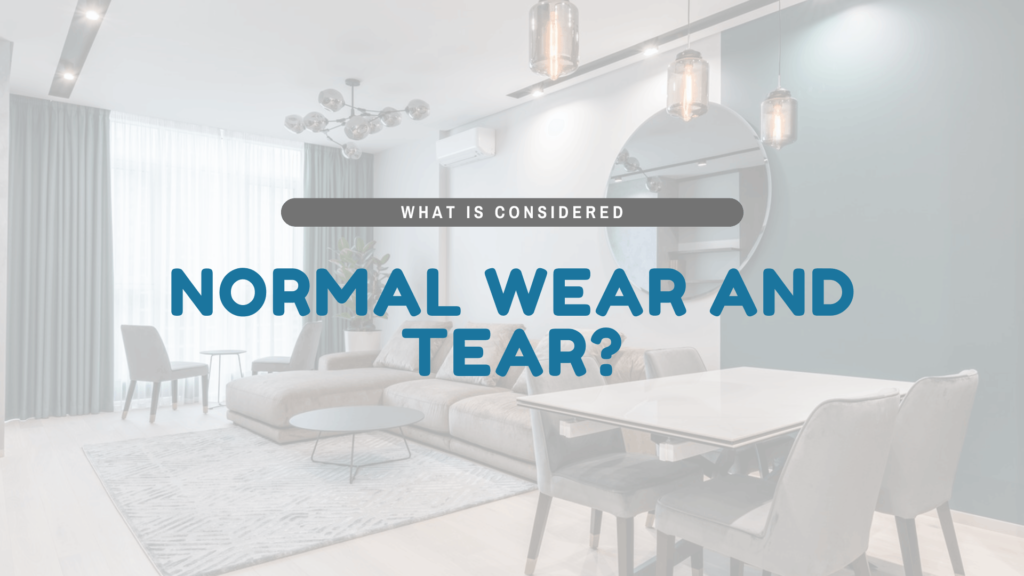
Wear and tear isn’t always an easy subject when we’re talking about rental property.
Once your tenants vacate your home, you’ll need to do your inspection as part of your turnover process – before you sign a new lease agreement. Normal wear and tear must be covered by property owners, but how do you know the difference between reasonable wear and tear and property damage in BC?
It isn’t always easy, but we have a few tips on identifying wear and tear in your rental properties.
Identifying Normal Wear and Tear in a BC Rental Property
Normal wear and tear is defined in the Residential Tenancy Branch (RTB) Policy Guideline 1 as deterioration that occurs over time from the use of the residential premises, even when the tenant provides reasonable care and maintenance. Essentially, it refers to the natural wear and tear that occurs due to regular use of the property.
For the purposes of rental property, reasonable wear and tear usually includes:
- Small nail holes in the wall from where a tenant might have hung pictures or mirrors or clocks
- Scuff marks on the walls and floorboards, or in the carpet from where furniture rested
- Worn carpet in high-traffic areas
- Paint that has faded due to sunlight or age
- Appliances needing repairs and replacements because they’ve been used every day
Landlords are responsible for these costs because they go with the expenses that you plan on when you buy an investment home. According to the Residential Tenancy Act, routine maintenance and upkeep of the property fall under the landlord’s duties.
Make sure you’re budgeting for wear and tear items during turnover periods. You cannot charge the tenant’s security deposit for issues related to wear and tear.
Keep in mind that both the landlord and the tenant have responsibilities in any Residential Tenancy Agreement in BC.
If landlords fail to make repairs, tenants can seek dispute resolution or make repairs themselves (with landlord approval). Additionally, tenants may have the option to withhold rent payments in accordance with British Columbia’s tenancy laws and use the withheld amount to pay rent for the necessary repairs.
Normal Wear and Tear vs Damage in BC
Property damage is different from wear and tear. It’s something that was caused by the tenant or a tenant’s guest, and it’s not the landlord’s responsibility to pay for it. Even if the damage resulted from a mistake or an accident, the tenant is still responsible to pay for it or complete the repair.
Can a Landlord Charge for Damages Cause by a Tenant?
Yes, a landlord can charge a tenant for damages caused by the tenant, but only for property damages that go beyond normal wear and tear.

Excessive damage results from intentional behavior or negligence by the tenant. Here are some examples of Excessive Damage:
- Cigarette burns on the carpet
- Broken mirrors
- Visible pet stains
- Claw marks on wooden floors
- Filthy or irreparably broken appliances
- Large holes in the wall
Maybe there’s a large hole in the wall from when a piece of furniture was being moved out. Or, a tenant’s child could have written on the walls in crayon or backed up the toilet by flushing a collection of unwanted toys.
Damage should be paid for out of the tenant’s security deposit, and to cover yourself and protect yourself against any claims or disputes, you need to document the damage. Inspections are important, especially inspections before the lease term begins and after the tenants move out.
If a tenant causes damage beyond normal wear and tear, landlords have the right to seek compensation – either via the damage deposit or via a cash payment from the tenant. If your tenant does not comply, you may have to begin the dispute resolution process through the RTB.
Move-In and Move-Out Reports
In order to properly determine whether there’s real damage left behind at your rental unit, you need to accurately document the home’s condition during your move out inspection before a new tenant moves in. Make sure you have pictures or videos to go with your descriptions and checklists. That way, if a tenant tries to claim that the door was hanging off its hinges when they moved in, you’ll have evidence to the contrary.
Security deposits are often an area of contention between landlords and tenants. Tenants tend to think that everything is wear and tear, and landlords may see everything as damage. A well-documented inspection report and good communication with your residents will help you avoid and manage any disagreements with prospective tenants.

If you have any questions about wear and tear or anything pertaining to managing your Kelowna investment property, please contact us at Vantage West Property Management.
